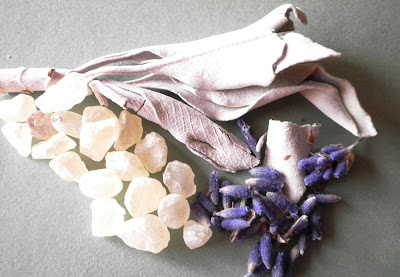We've all seen magicians toss magic powder into the air with
a flourish, resulting in colored smoke, a disappearance, or a cute bunny
showing up unexpectedly. In many ways
loose incense has that same sort of magical effect (without the bunnies). Set some resin blended with herbs or woods to
a sufficient heat source, and the air is infused with scents evocative of
wooded glens, summer gardens or autumn cookspaces.
Years ago my sister and I were the herb ladies at a local
renaissance festival. We were known for
our "herb walls", pegboard lined walls which held hundreds of
pre-weighed ounce packages of herbs. We
kept what we called a "shake" bag of all the bits left over after weighing
the pounds into ounces. Our antique
scale never gave us more than 15 ounces per pound, so there were always
leftovers. In order to create interest
and draw customers, we kept charcoal disks burning and periodically sprinkled a
pinch of this random blend over them. So
began our love of incense making.
This loose form of incense is the simplest, and in many ways
the most creative method. Whereas formed
incense line cones and sticks require very specific measurements and ratios of
ingredients, there are no such barriers for loose blends.
Most often, a very scant pinch of the blend smolders upon a
specially made self-igniting charcoal disk.
Care must be taken because indoors the smoke can be overwhelming unless
a light hand is used. Resins can be simmered
in water; a blend of lavender buds and frankincense is lovely simmered or
smoldered. Blends can be tossed into
campfires or heated woodstoves. For the
most part though, incense is burned.
Blending is where personal preferences come into play. For instance, to me a blend starts with a
resin (pine, copal, myrrh, frankincense, dragon's blood, etc) but may not be at
all important to someone else. Yellow
sandalwood was at one time de rigueur but in recent years it has become too
precious and so we save it for very special blends and use it sparingly. Powdered or cut and sifted fragrant herbs and
spices are good inclusions. Many other
symbolic additions are possible in small quantities too.
We live on a Christmas tree farm, and the trees are trimmed
each summer. In the fall and again in
January, I gather the drying drops of sap that results from the cuts to the
trees and put that sticky mixture in the deep freeze for a year to dry out. It is my favorite resin to use for personal
blends because it means a lot to me.
Along with that, I blend herbs that I've grown over the
summer. Lavender, thyme, lemon verbena,
sages, basils, mints, and many other plants from the garden or found in the
wild can be used. Incenses can be made
in a way that uses the language of flowers to make them meaningful, they can be
carefully designed, or they can be a haphazard mixture of the things that make
you happy.
Sometimes burning changes the scents of substances in
surprising ways. To find out
if a scent remains true, light a charcoal disk and burn the tiniest pinch
of each of the substances being considered.
It was a surprise to us that orange peel was unpleasant when burned.
Essential oils (and synthetic fragrance oils) almost always
retain their true scents when burned, and a very small quantity goes a long
way.
As always, record the blend as it is being created. It would be sad to stumble upon the ultimate
blend and not be able to duplicate it.
Make very small batches.
If it is perfect and the recipe is recorded, more can always be made
later. If it doesn't turn out as was
hoped, using a teaspoon measure or smaller as "a part" (as in one
part resin, 1/2 part lavender, 1 part rose petals, 2 drops patchouli essential
oil, for instance) means that much less material will be wasted.
Most importantly, enjoy the process and trust your own
creativity. Going back to our shake bag
from the renaissance faire, it should be fairly clear that it is difficult to
blend a loose incense that is bad.
Some people require something like a recipe, so in that case
here is one of ratios that I tend towards:
1 part
resin (small chunks or powdered)
3 to 4
parts dried botanicals and/or wood powder
1 drop
essential or fragrance oil per teaspoon (optional)
Store in an air-tight container out of the light and it will
last for years. Depending on the
ingredients the scent might fade somewhat as years pass, but I have some
that is close to 2 decades old that are still delightful.
Some simple blends...
1 part myrrh
2 parts ground patchouli
2 parts ground lavender buds
4 drops patchouli essential oil
mix well
1 part copal
3 parts white sage
1 part cedar tips or ground wood
grind together in mortar and pestle
1 part frankincense
2 parts lemon verbena
2 parts rosemary



2 comments:
I really like how you described blending and the recipes you give!!!
Your blend recipes sound lovely.
Thanks for posting this.
Post a Comment